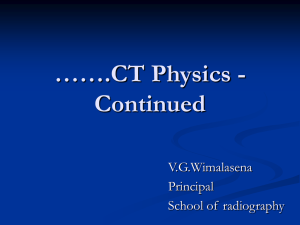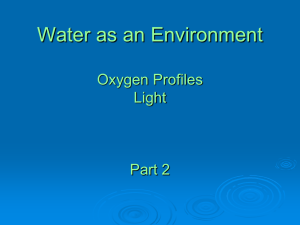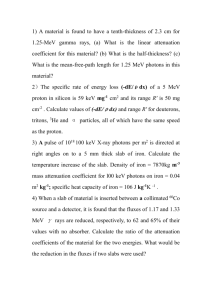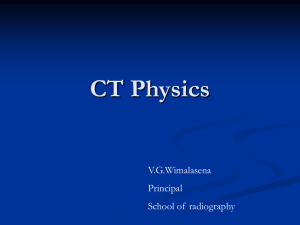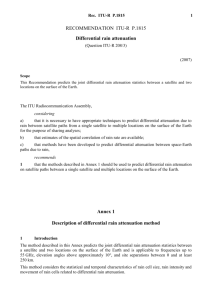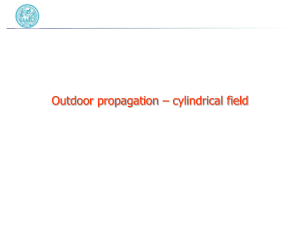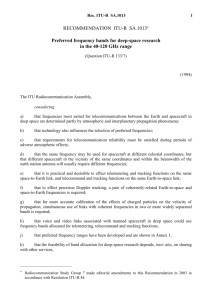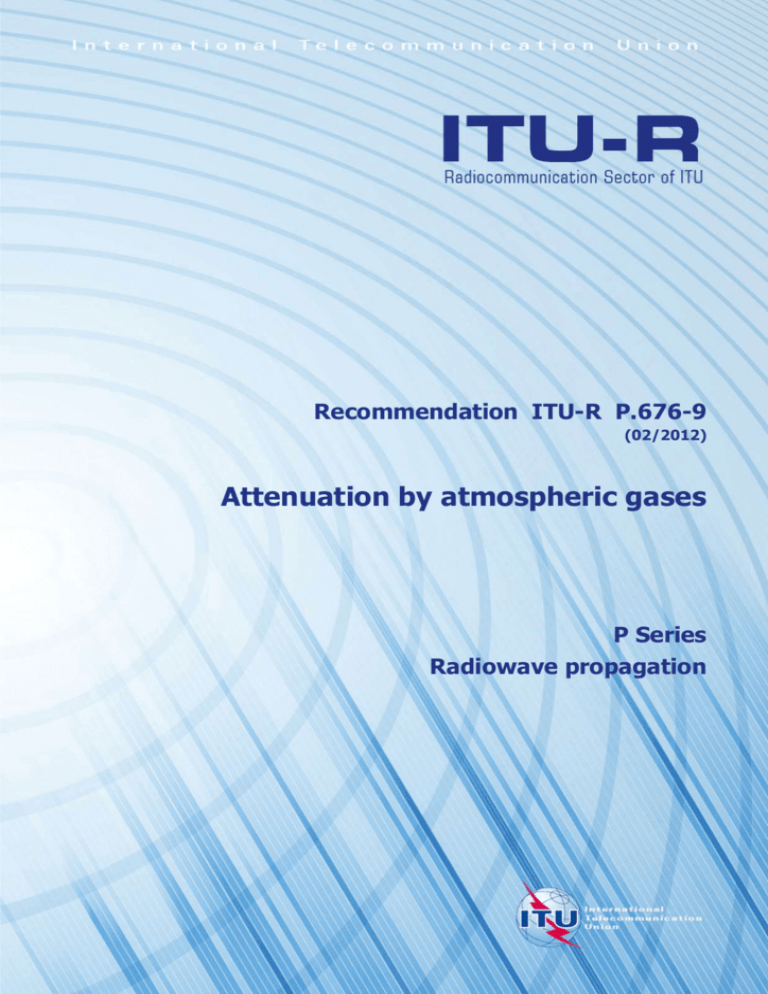
Recommendation ITU-R P.676-9
(02/2012)
Attenuation by atmospheric gases
P Series
Radiowave propagation
ii
Rec. ITU-R P.676-9
Foreword
The role of the Radiocommunication Sector is to ensure the rational, equitable, efficient and economical use of the
radio-frequency spectrum by all radiocommunication services, including satellite services, and carry out studies without
limit of frequency range on the basis of which Recommendations are adopted.
The regulatory and policy functions of the Radiocommunication Sector are performed by World and Regional
Radiocommunication Conferences and Radiocommunication Assemblies supported by Study Groups.
Policy on Intellectual Property Right (IPR)
ITU-R policy on IPR is described in the Common Patent Policy for ITU-T/ITU-R/ISO/IEC referenced in Annex 1 of
Resolution ITU-R 1. Forms to be used for the submission of patent statements and licensing declarations by patent
holders are available from http://www.itu.int/ITU-R/go/patents/en where the Guidelines for Implementation of the
Common Patent Policy for ITU-T/ITU-R/ISO/IEC and the ITU-R patent information database can also be found.
Series of ITU-R Recommendations
(Also available online at http://www.itu.int/publ/R-REC/en)
Series
BO
BR
BS
BT
F
M
P
RA
RS
S
SA
SF
SM
SNG
TF
V
Title
Satellite delivery
Recording for production, archival and play-out; film for television
Broadcasting service (sound)
Broadcasting service (television)
Fixed service
Mobile, radiodetermination, amateur and related satellite services
Radiowave propagation
Radio astronomy
Remote sensing systems
Fixed-satellite service
Space applications and meteorology
Frequency sharing and coordination between fixed-satellite and fixed service systems
Spectrum management
Satellite news gathering
Time signals and frequency standards emissions
Vocabulary and related subjects
Note: This ITU-R Recommendation was approved in English under the procedure detailed in Resolution ITU-R 1.
Electronic Publication
Geneva, 2012
ITU 2012
All rights reserved. No part of this publication may be reproduced, by any means whatsoever, without written permission of ITU.
Rec. ITU-R P.676-9
1
RECOMMENDATION ITU-R P.676-9
Attenuation by atmospheric gases
(Question ITU-R 201/3)
(1990-1992-1995-1997-1999-2001-2005-2007-2009-2012)
Scope
Recommendation ITU-R P.676 provides methods to estimate the attenuation of atmospheric gases on
terrestrial and slant paths using:
a)
an estimate of gaseous attenuation computed by summation of individual absorption lines that is
valid for the frequency range 1-1 000 GHz, and
b)
a simplified approximate method to estimate gaseous attenuation that is applicable in the frequency
range 1-350 GHz.
The ITU Radiocommunication Assembly,
considering
a)
the necessity of estimating the attenuation by atmospheric gases on terrestrial and slant
paths,
recommends
1
that, for general application, the procedures in Annex 1 be used to calculate gaseous
attenuation at frequencies up to 1 000 GHz;
2
that, for approximate estimates of gaseous attenuation in the frequency range 1 to 350 GHz,
the computationally less intensive procedure given in Annex 2 be used.
Annex 1
Line-by-line calculation of gaseous attenuation
1
Specific attenuation
The specific attenuation at frequencies up to 1 000 GHz due to dry air and water vapour, can be
evaluated most accurately at any value of pressure, temperature and humidity by means of a
summation of the individual resonance lines from oxygen and water vapour, together with small
additional factors for the non-resonant Debye spectrum of oxygen below 10 GHz, pressure-induced
nitrogen attenuation above 100 GHz and a wet continuum to account for the excess water vapourabsorption found experimentally. Figure 1 shows the specific attenuation using the model,
calculated from 0 to 1 000 GHz at 1 GHz intervals, for a pressure of 1 013 hPa, temperature of
15 C for the cases of a water-vapour density of 7.5 g/m3 (Curve A) and a dry atmosphere
(Curve B).
2
Rec. ITU-R P.676-9
Near 60 GHz, many oxygen absorption lines merge together, at sea-level pressures, to form a
single, broad absorption band, which is shown in more detail in Fig. 2. This figure also shows the
oxygen attenuation at higher altitudes, with the individual lines becoming resolved at lower
pressures. Some additional molecular species (e.g. oxygen isotopic species, oxygen vibrationally
excited species, ozone, ozone isotopic species, and ozone vibrationally excited species, and other
minor species) are not included in the line-by-line prediction method. These additional lines are
insignificant for typical atmospheres, but may be important for a dry atmosphere.
For quick and approximate estimates of specific attenuation at frequencies up to 350 GHz, in cases
where high accuracy is not required, simplified algorithms are given in Annex 2 for restricted
ranges of meteorological conditions.
The specific gaseous attenuation is given by:
o w 0.1820 f N" ( f )
dB/km
(1)
where o and w are the specific attenuations (dB/km) due to dry air (oxygen, pressure-induced
nitrogen and non-resonant Debye attenuation) and water vapour, respectively, and where f is the
frequency (GHz) and N ( f is the imaginary part of the frequency-dependent complex refractivity:
N" ( f ) Si Fi N"D ( f )
(2)
i
Si is the strength of the i-th line, Fi is the line shape factor and the sum extends over all the lines (for
frequencies, f, above 118.750343 GHz oxygen line, only the oxygen lines above 60 GHz complex
should be included in the summation; the summation should begin at i = 38 rather than at i = 1);
N"D ( f ) is the dry continuum due to pressure-induced nitrogen absorption and the Debye spectrum.
The line strength is given by:
Si a1 10 –7 p 3 exp a2 (1 – θ)
b1 10
–1
3.5
e
exp b2 (1 – θ)
for oxygen
(3)
for water vapour
where:
p:
dry air pressure (hPa)
e:
water vapour partial pressure in hPa (total barometric pressure ptot p e)
T:
300/T
temperature (K).
Specific attenuation (dB/km)
10
10
10
10
10
10
10
10
10
2
5
2
5
2
5
2
5
2
5
2
5
–3
2
5
–2
2
5
–1
1
2
3
4
5
0
100
200
Standard
300
400
Frequency (GHz)
500
Dry
600
(Standard: 7.5 g/m3; Dry: 0 g/m3)
700
800
900
1 000
Rec. ITU-R P.676-9
3
FIGURE 1
Specific attenuation due to atmospheric gases, calculated at 1 GHz intervals, including line centres
Specific attenuation (dB/km)
2
10
10
10
2
5
2
5
2
5
–3
2
5
–2
2
5
–1
1
10
10
50
52
54
56
58
Frequency (GHz)
60
62
(0 km, 5 km, 10 km, 15 km and 20 km)
64
66
68
70
20
15
10
5
0
4
Rec. ITU-R P.676-9
FIGURE 2
Specific attenuation in the range 50-70 GHz at the altitudes indicated
Rec. ITU-R P.676-9
5
Local values of p, e and T measured profiles (e.g. using radiosondes) should be used; however, in
the absence of local information, the reference standard atmospheres described in Recommendation ITU-R P.835 should be used. (Note that where total atmospheric attenuation is being
calculated, the same-water vapour partial pressure is used for both dry-air and water-vapour
attenuations.)
The water-vapour partial pressure, e, may be obtained from the water-vapour density using the
expression:
e
T
216.7
(4)
The coefficients a1, a2 are given in Table 1 for oxygen, those for water vapour, b1 and b2, are given
in Table 2.
The line-shape factor is given by:
Fi
f – fi f
f f – fi – f
fi fi – f 2 f 2
fi f 2 f 2
(5)
where fi is the line frequency and f is the width of the line:
f a3 10– 4 ( p θ (0.8 – a4 ) 1.1 e θ)
b3 10
–4
(p θ
b4
for oxygen
(6a)
b6
b5 e θ )
for water vapour
The line width f is modified to account for Doppler broadening:
f f 2 2.25 106
for oxygen
2.1316 1012 f i2
0.535f 0.217f
2
(6b)
for water vapour
is a correction factor which arises due to interference effects in oxygen lines:
(a5 a6) 104 ( p e) 0.8
0
The spectroscopic coefficients are given in Tables 1 and 2.
for oxygen
for water vapour
(7)
6
Rec. ITU-R P.676-9
TABLE 1
Spectroscopic data for oxygen attenuation
f0
50.474238
50.987749
51.503350
52.021410
52.542394
53.066907
53.595749
54.130000
54.671159
55.221367
55.783802
56.264775
56.363389
56.968206
57.612484
58.323877
58.446590
59.164207
59.590983
60.306061
60.434776
61.150560
61.800154
62.411215
62.486260
62.997977
63.568518
64.127767
64.678903
65.224071
65.764772
66.302091
66.836830
67.369598
67.900867
68.431005
68.960311
118.750343
368.498350
424.763124
487.249370
715.393150
773.839675
834.145330
a1
.94
2.46
6.08
14.14
31.02
64.10
124.70
228.00
391.80
631.60
953.50
548.90
1 344.00
1 763.00
2 141.00
2 386.00
1 457.00
2 404.00
2 112.00
2 124.00
2 461.00
2 504.00
2 298.00
1 933.00
1 517.00
1 503.00
1 087.00
733.50
463.50
274.80
153.00
80.09
39.46
18.32
8.01
3.30
1.28
945.00
67.90
638.00
235.00
99.60
671.00
180.00
a2
9.694
8.694
7.744
6.844
6.004
5.224
4.484
3.814
3.194
2.624
2.119
.015
1.660
1.260
.915
.626
.084
.391
.212
.212
.391
.626
.915
1.260
.083
1.665
2.115
2.620
3.195
3.815
4.485
5.225
6.005
6.845
7.745
8.695
9.695
.009
.049
.044
.049
.145
.130
.147
a3
8.90
9.10
9.40
9.70
9.90
10.20
10.50
10.70
11.00
11.30
11.70
17.30
12.00
12.40
12.80
13.30
15.20
13.90
14.30
14.50
13.60
13.10
12.70
12.30
15.40
12.00
11.70
11.30
11.00
10.70
10.50
10.20
9.90
9.70
9.40
9.20
9.00
16.30
19.20
19.30
19.20
18.10
18.20
18.10
a4
.0
.0
.0
.0
.0
.0
.0
.0
.0
.0
.0
.0
.0
.0
.0
.0
.0
.0
.0
.0
.0
.0
.0
.0
.0
.0
.0
.0
.0
.0
.0
.0
.0
.0
.0
.0
.0
.0
.6
.6
.6
.6
.6
.6
a5
2.400
2.200
1.970
1.660
1.360
1.310
2.300
3.350
3.740
2.580
–1.660
3.900
–2.970
–4.160
–6.130
–2.050
7.480
–7.220
7.650
–7.050
6.970
1.040
5.700
3.600
–4.980
2.390
1.080
–3.110
–4.210
–3.750
–2.670
–1.680
–1.690
–2.000
–2.280
–2.400
–2.500
–.360
.000
.000
.000
.000
.000
.000
a6
7.900
7.800
7.740
7.640
7.510
7.140
5.840
4.310
3.050
3.390
7.050
–1.130
7.530
7.420
6.970
.510
–1.460
2.660
–.900
.810
–3.240
–.670
–7.610
–7.770
.970
–7.680
–7.060
–3.320
–2.980
–4.230
–5.750
–7.000
–7.350
–7.440
–7.530
–7.600
–7.650
.090
.000
.000
.000
.000
.000
.000
Rec. ITU-R P.676-9
7
TABLE 2
Spectroscopic data for water-vapour attenuation
f0
b1
b2
b3
b4
b5
b6
22.235080
0.1130
2.143
28.11
.69
4.800
1.00
67.803960
0.0012
8.735
28.58
.69
4.930
.82
119.995940
0.0008
8.356
29.48
.70
4.780
.79
183.310091
2.4200
.668
30.50
.64
5.300
.85
321.225644
0.0483
6.181
23.03
.67
4.690
.54
325.152919
1.4990
1.540
27.83
.68
4.850
.74
336.222601
0.0011
9.829
26.93
.69
4.740
.61
380.197372
11.5200
1.048
28.73
.54
5.380
.89
390.134508
0.0046
7.350
21.52
.63
4.810
.55
437.346667
0.0650
5.050
18.45
.60
4.230
.48
439.150812
0.9218
3.596
21.00
.63
4.290
.52
443.018295
0.1976
5.050
18.60
.60
4.230
.50
448.001075
10.3200
1.405
26.32
.66
4.840
.67
470.888947
0.3297
3.599
21.52
.66
4.570
.65
474.689127
1.2620
2.381
23.55
.65
4.650
.64
488.491133
0.2520
2.853
26.02
.69
5.040
.72
503.568532
0.0390
6.733
16.12
.61
3.980
.43
504.482692
0.0130
6.733
16.12
.61
4.010
.45
547.676440
9.7010
.114
26.00
.70
4.500
1.00
552.020960
14.7700
.114
26.00
.70
4.500
1.00
556.936002
487.4000
.159
32.10
.69
4.110
1.00
620.700807
5.0120
2.200
24.38
.71
4.680
.68
645.866155
0.0713
8.580
18.00
.60
4.000
.50
658.005280
0.3022
7.820
32.10
.69
4.140
1.00
752.033227
239.6000
.396
30.60
.68
4.090
.84
841.053973
0.0140
8.180
15.90
.33
5.760
.45
859.962313
0.1472
7.989
30.60
.68
4.090
.84
899.306675
0.0605
7.917
29.85
.68
4.530
.90
902.616173
0.0426
8.432
28.65
.70
5.100
.95
906.207325
0.1876
5.111
24.08
.70
4.700
.53
916.171582
8.3400
1.442
26.70
.70
4.780
.78
923.118427
0.0869
10.220
29.00
.70
5.000
.80
970.315022
8.9720
1.920
25.50
.64
4.940
.67
987.926764
132.1000
.258
29.85
.68
4.550
.90
1 780.000000
22 300.0000
.952
176.20
.50
30.500
5.00
8
Rec. ITU-R P.676-9
The dry air continuum arises from the non-resonant Debye spectrum of oxygen below 10 GHz and a
pressure-induced nitrogen attenuation above 100 GHz.
6.14 10 –5
1.4 10 12 p 1.5
N"D ( f ) f p 2
2
1 1.9 105 f 1.5
f
d
1
d
(8)
where d is the width parameter for the Debye spectrum:
d 5.6 10 4 p e 0.8
2
Path attenuation
2.1
Terrestrial paths
(9)
For a terrestrial path, or for slightly inclined paths close to the ground, the path attenuation, A, may
be written as:
A r0 o w r0
dB
(10)
where r0 is path length (km).
2.2
Slant paths
This section gives a method to integrate the specific attenuation calculated using the line-by-line
model given above, at different pressures, temperatures and humidities through the atmosphere. By
this means, the path attenuation for communications systems with any geometrical configuration
within and external to the Earth's atmosphere may be accurately determined simply by dividing the
atmosphere into horizontal layers, specifying the profile of the meteorological parameters pressure,
temperature and humidity along the path. In the absence of local profiles, from radiosonde data, for
example, the reference standard atmospheres in Recommendation ITU-R P.835 may be used, either
for global application or for low (annual), mid (summer and winter) and high latitude (summer and
winter) sites.
Figure 3 shows the zenith attenuation calculated at 1 GHz intervals with this model for the global
reference standard atmosphere in Recommendation ITU-R P.835, with horizontal layers 1 km thick
and summing the attenuations for each layer, for the cases of a moist atmosphere (Curve A) and a
dry atmosphere (Curve B).
The total slant path attenuation, A(h, ), from a station with altitude, h, and elevation angle, , can
be calculated as follows when 0:
Ah,
H
dH
h sin
(11)
Rec. ITU-R P.676-9
9
where the value of can be determined as follows based on Snell’s law in polar coordinates:
c
arccos
( r H ) n( H )
(12)
c (r h) n(h) cos
(13)
where:
where n(h) is the atmospheric radio refractive index, calculated from pressure, temperature and
water-vapour pressure along the path (see Recommendation ITU-R P.835) using Recommendation ITU-R P.453.
On the other hand, when 0, there is a minimum height, hmin, at which the radio beam becomes
parallel with the Earth’s surface. The value of hmin can be determined by solving the following
transcendental equation:
r hmin nhmin c
(14)
This can be easily solved by repeating the following calculation, using hmin h as an initial value:
h'min
c
– r
nhmin
(15)
Therefore, A(h, ) can be calculated as follows:
Ah,
h H
H
dH
dH
hm in sin
hm in sin
(16)
In carrying out the integration of equations (11) and (16), care should be exercised in that the
integrand becomes infinite at 0. However, this singularity can be eliminated by an appropriate
variable conversion, for example, by using u4 H – h in equation (11) and u4 H – hmin in
equation (16).
A numerical solution for the attenuation due to atmospheric gases can be implemented with the
following algorithm.
To calculate the total attenuation for a satellite link, it is necessary to know not only the specific
attenuation at each point of the link but also the length of path that has that specific attenuation. To
derive the path length it is also necessary to consider the ray bending that occurs in a spherical
Earth.
Using Fig. 4 as a reference, an is the path length through layer n with thickness n that has
refractive index nn. n and n are the entry and exiting incidence angles. rn are the radii from the
centre of the Earth to the beginning of layer n. an can then be expressed as:
an rn cos n
1
4 rn2 cos 2 n 8 rn n 4 2n
2
(17)
The angle n can be calculated from:
an2 2 rn n 2n
n arccos
2 an rn 2 an n
(18)
10
Rec. ITU-R P.676-9
1 is the incidence angle at the ground station (the complement of the elevation angle φ). n 1 can
be calculated from n using Snell’s law that in this case becomes:
n
n 1 arcsin n sin n
nn 1
(19)
where nn and nn 1 are the refractive indexes of layers n and n 1.
Equation (19) may become invalid at very low elevation angles (φ < 1°) when radiosonde data from
certain regions of the world susceptible to ducting conditions are used as input. In such cases, air
layers with radio refractivity gradients smaller in magnitude than −157 N/km are present and the
ray-tracing algorithm (equations (17) to (19)), based on geometrical optics, is no longer applicable.
The arcsine function in equation (19) becomes complex under these anomalous conditions since its
argument is then slightly larger than 1. It should be noted that equation (19) is valid for all elevation
angles when the reference standard atmospheres described in Recommendation ITU-R P.835 are
used as input, since these idealized atmospheres – clearly without strong negative refractivity
gradients – do not support such anomalous propagation conditions.
Zenith attenuation (dB)
2
5
2
5
2
5
2
5
2
5
2
5
2
5
2
5
10
–3
10
–2
10
–1
10
10
1
10
2
10
3
10
4
10
5
0
100
200
Dry
Standard
300
400
Frequency (GHz)
500
600
(Standard: 7.5 g/m3 at sea level; Dry: 0 g/m3)
700
800
900
1 000
Rec. ITU-R P.676-9
11
FIGURE 3
Zenith attenuation due to atmospheric gases, calculated at 1 GHz intervals, including line centres
12
Rec. ITU-R P.676-9
The remaining frequency dependent (dispersive) term has a marginal influence on the result (around
1%) but can be calculated from the method shown in the ITU-R Handbook on Radiometeorology.
The total attenuation can be derived using:
Agas
k
an n
(20)
dB
n 1
where n is the specific attenuation derived from equation (1).
To ensure an accurate estimate of the path attenuation, the thickness of the layers should increase
exponentially, from 10 cm at the lowest layer (ground level) to 1 km at an altitude of 100 km,
according to the following equation:
i 1
i 0.0001 exp
100
from i 1 to 922, noting that 922 1.0 km and
km
(21)
i 1 i 100 km.
922
For Earth-to-space applications, the integration should be performed at least up to 30 km, and up to
100 km at the oxygen line-centre frequencies.
FIGURE 4
2
yer
La
2
1 a
1
a3
2
1
n2
1
yer
La
3
a2
n1
r1
r2
r3
Rec. ITU-R P.676-9
3
13
Dispersive effects
The effects of dispersion are discussed in the ITU-R Handbook on Radiometeorology, which
contains a model for calculating dispersion based on the line-by-line calculation. For practical
purposes, dispersive effects should not impose serious limitations on millimetric terrestrial
communication systems operating with bandwidths of up to a few hundred MHz over short ranges
(for example, less than about 20 km), especially in the window regions of the spectrum, at
frequencies removed from the centres of major absorption lines. For satellite communication
systems, the longer path lengths through the atmosphere will constrain operating frequencies further
to the window regions, where both atmospheric attenuation and the corresponding dispersion are
low.
Annex 2
Approximate estimation of gaseous attenuation
in the frequency range 1-350 GHz
This Annex contains simplified algorithms for quick, approximate estimation of gaseous attenuation
for a limited range of meteorological conditions and a limited variety of geometrical configurations.
1
Specific attenuation
The specific attenuation due to dry air and water vapour, from sea level to an altitude of 10 km, can
be estimated using the following simplified algorithms, which are based on curve-fitting to the lineby-line calculation, and agree with the more accurate calculations to within an average of about
10% at frequencies removed from the centres of major absorption lines. The absolute difference
between the results from these algorithms and the line-by-line calculation is generally less than
0.1 dB/km and reaches a maximum of 0.7 dB/km near 60 GHz. For altitudes higher than 10 km, and
in cases where higher accuracy is required, the line-by-line calculation should be used.
For dry air, the attenuation o (dB/km) is given by the following equations:
For f 54 GHz:
7.2 rt 2.8
0.62 3
f 2 r p2 10 3
o 2
2 1.6
1.161
f 0.34 r p rt
(54 f )
0.83 2
(22a)
For 54 GHz < f 60 GHz:
ln
ln 58
ln 60
o exp 54 ( f 58)( f 60)
( f 54)( f 60)
( f 54)( f 58)
8
12
24
(22b)
For 60 GHz < f 62 GHz:
o 60 ( 62 60 )
f 60
2
(22c)
14
Rec. ITU-R P.676-9
For 62 GHz < f 66 GHz:
ln 62
ln 64
ln 66
o exp
( f 64)( f 66)
( f 62)( f 66)
( f 62)( f 64)
4
8
8
(22d)
For 66 GHz < f 120 GHz:
0.283 rt3.8
0.502 6 [1 0.0163 7 ( f 66 )]
2 2
3
o 3.02 10 4 rt3.5
f rp 10
2
2 1.6
1.4346 4
( f 118 .75) 2.91rp rt
( f 66 )
1.155
(22e)
For 120 GHz < f 350 GHz:
3.02 104
2 2 3.5
0.283rt0.3
3
o
f rp rt 10
5 1.5
2
2 1.6
( f 118.75) 2.91rp rt
1 1.9 10 f
(22f)
1 (rp , rt ,0.0717,1.8132,0.0156,1.6515)
(22g)
2 (rp , rt ,0.5146,4.6368,0.1921,5.7416)
(22h)
3 (rp , rt ,0.3414,6.5851,0.2130,8.5854)
(22i)
4 (rp , rt ,0.0112,0.0092,0.1033,0.0009)
(22j)
5 (rp , rt ,0.2705,2.7192,0.3016,4.1033)
(22k)
6 (rp , rt ,0.2445,5.9191,0.0422,8.0719)
(22l)
7 (rp , rt ,0.1833,6.5589,0.2402,6.131)
(22m)
54 2.192(rp , rt ,1.8286,1.9487,0.4051,2.8509)
(22n)
58 12.59(rp , rt ,1.0045,3.5610,0.1588,1.2834)
(22o)
60 15.0(rp , rt ,0.9003,4.1335,0.0427,1.6088)
(22p)
62 14.28(rp , rt ,0.9886,3.4176,0.1827,1.3429)
(22q)
64 6.819(rp , rt ,1.4320,0.6258,0.3177,0.5914)
(22r)
66 1.908(rp , rt ,2.0717,4.1404,0.4910,4.8718)
(22s)
0.00306(rp , rt ,3.211,14.94,1.583,16.37)
(22t)
(rp , rt , a, b, c, d ) rpa rtb exp[ c(1 rp ) d (1 rt )]
(22u)
with:
Rec. ITU-R P.676-9
15
where:
f:
rp =
frequency (GHz)
ptot/1013, where ptot represents total air pressure
rt
288/(273 t)
p:
pressure (hPa)
t:
temperature (C), where mean temperature values can be obtained from maps
given in Recommendation ITU-R P.1510, when no adequate temperature data
are available.
For water vapour, the attenuation w (dB/km) is given by:
3.981 exp[ 2.23(1 rt )]
11.961 exp[ 0.7(1 rt )]
w
g ( f ,22)
2
2
( f 22.235) 9.421
( f 183.31) 2 11.1412
0.0811 exp[ 6.44(1 rt )]
3.661 exp[1.6(1 rt )]
( f 321.226) 2 6.2912 ( f 325.153) 2 9.2212
25.371 exp[1.09(1 rt )] 17.41 exp[1.46(1 rt )]
( f 380) 2
( f 448) 2
844.61 exp[ 0.17(1 rt )]
2901 exp[ 0.41(1 rt )]
g ( f ,557)
g ( f ,752)
2
( f 557)
( f 752) 2
8.3328 10 4 2 exp[ 0.99(1 rt )]
( f 1 780) 2
(23a)
g ( f ,1 780) f 2 rt2.5 10 4
with:
1 0.955rp rt0.68 0.006
(23b)
2 0.735 r p rt0.5 0.0353 rt4
(23c)
f fi
g ( f , f i ) 1
f fi
2
(23d)
where is the water-vapour density (g/m3).
Figure 5 shows the specific attenuation from 1 to 350 GHz at sea-level for dry air and water vapour
with a density of 7.5 g/m3.
2
Path attenuation
2.1
Terrestrial paths
For a horizontal path, or for slightly inclined paths close to the ground, the path attenuation, A, may
be written as:
A r0 ( o w ) r0 dB
where r0 is the path length (km).
(24)
16
Rec. ITU-R P.676-9
FIGURE 5
Specific attenuation due to atmospheric gases
10
2
5
2
10
Total
5
Specific attenuation (dB/km)
2
1
5
2
10
–1
5
2
Dry air
Total
10
–2
5
Water vapour
2
10
–3
1
2
5
10
2
Frequency (GHz)
Pressure: 1 013 hPa
Temperature: 15° C
3
Water vapour density: 7.5 g/m
5
2
10
2
3.5
Rec. ITU-R P.676-9
2.2
17
Slant paths
This section contains simple algorithms for estimating the gaseous attenuation along slant paths
through the Earth’s atmosphere, by defining an equivalent height by which the specific attenuation
calculated in § 1 may be multiplied to obtain the zenith attenuation. The equivalent heights are
dependent on pressure, and can hence be employed for determining the zenith attenuation from sea
level up to an altitude of about 10 km. The resulting zenith attenuations are accurate to within 10%
for dry air and 5% for water vapour from sea level up to altitudes of about 10 km, using the
pressure, temperature and water-vapour density appropriate to the altitude of interest. For altitudes
higher than 10 km, and particularly for frequencies within 0.5 GHz of the centres of resonance lines
at any altitude, the procedure in Annex 1 should be used. Note that the Gaussian function in
equation (25b) describing the oxygen equivalent height in the 60 GHz band can yield errors higher
than 10% at certain frequencies, since this procedure cannot reproduce the structure shown in
Fig. 7. The expressions below were derived from zenith attenuations calculated with the procedure
in Annex 1, integrating the attenuations numerically over a bandwidth of 500 MHz; the resultant
attenuations hence effectively represent approximate minimum values in the 50-70 GHz band. The
path attenuation at elevation angles other than the zenith may then be determined using the
procedures described later in this section.
For dry air, the equivalent height is given by:
ho
6.1
1 0.17 rp1.1
(1 t1 t 2 t3 )
(25a)
where:
t1
4.64
1 0.066 rp2.3
t2
t3
2
f 59.7
exp
2.87 12.4 exp (7.9 rp )
0.14 exp (2.12 rp )
( f 118.75) 2 0.031 exp (2.2 rp )
0.0114
1 0.14 rp2.6
f
0.0247 0.0001 f 1.61 10 6 f 2
1 0.0169 f 4.1 10 5 f 2 3.2 10 7 f 3
(25b)
(25c)
(25d)
with the constraint that:
ho 10.7 rp0.3 when f 70 GHz
(25e)
and for water vapour, the equivalent height is:
1.39 w
3.37 w
1.58 w
hw 1.66 1
2
2
2
( f 22 .235 ) 2.56 w ( f 183 .31) 4.69 w ( f 325 .1) 2.89 w
(26a)
for f 350 GHz
w
1.013
1 exp [8.6 (rp 0.57)]
(26b)
The zenith attenuation between 50 to 70 GHz is a complicated function of frequency, as shown in
Fig. 7, and the above algorithms for equivalent height can provide only an approximate estimate, in
general, of the minimum levels of attenuation likely to be encountered in this frequency range. For
greater accuracy, the procedure in Annex 1 should be used.
18
Rec. ITU-R P.676-9
The concept of equivalent height is based on the assumption of an exponential atmosphere specified
by a scale height to describe the decay in density with altitude. Note that scale heights for both dry
air and water vapour may vary with latitude, season and/or climate, and that water vapour distributions in the real atmosphere may deviate considerably from the exponential, with corresponding
changes in equivalent heights. The values given above are applicable up to altitudes of about 10 km.
The total zenith attenuation is then:
A o ho w hw
(27)
dB
Figure 6 shows the total zenith attenuation at sea level, as well as the attenuation due to dry air and
water vapour, using the mean annual global reference atmosphere given in Recommendation
ITU-R P.835. Between 50 and 70 GHz greater accuracy can be obtained from the 0 km curve in
Fig. 7 which was derived using the line-by-line calculation as described in Annex 1.
2.2.1
2.2.1.1
Elevation angles between 5 and 90
Earth-space paths
For an elevation angle, , between 5 and 90°, the path attenuation is obtained using the cosecant
law, as follows:
For path attenuation based on surface meteorological data:
A
where Ao ho o
and
Ao Aw
sin
(28)
dB
Aw hw w
and for path attenuation based on integrated water vapour content:
A Aw ( P)
A( P) o
sin
(29)
dB
where Aw (P) is given in § 2.3.
2.2.1.2
Inclined paths
To determine the attenuation values on an inclined path between a station situated at altitude h1 and
another at a higher altitude h2, where both altitudes are less than 10 km above mean sea level, the
values ho and hw in equation (28) must be replaced by the following ho' and hw' values:
e
ho' ho e – h1 / ho – e – h2 / ho
' hw
hw
– h1 / hw
– e – h2 / hw
km
(30)
km
(31)
it being understood that the value of the water-vapour density used in equation (23) is the hypothetical value at sea level calculated as follows:
1 exp h1 / 2
(32)
where 1 is the value corresponding to altitude h1 of the station in question, and the equivalent
height of water vapour density is assumed as 2 km (see Recommendation ITU-R P.835).
Equations (30), (31) and (32) use different normalizations for the dry air and water-vapour
equivalent heights. While the mean air pressure referred to sea level can be considered constant
around the world (equal to 1 013 hPa), the water-vapour density not only has a wide range of
Rec. ITU-R P.676-9
19
climatic variability but is measured at the surface (i.e. at the height of the ground station). For
values of surface water-vapour density, see Recommendation ITU-R P.836.
2.2.2
2.2.2.1
Elevation angles between 0º and 5º
Earth-space paths
In this case, Annex 1 of this Recommendation should be used. The same Annex should also be used
for elevations less than zero.
2.2.2.2
Inclined paths
The attenuation on an inclined path between a station situated at altitude h1 and a higher altitude h2
(where both altitudes are less than 10 km above mean sea level), can be determined from the
following:
A o
R h F( x ) e – h1 / ho
1
ho e 1
–
cos 1
Re h2 F( x2 ) e – h2 / ho
cos 2
R h F( x ' ) e – h1 / hw
1
w hw e 1
–
cos 1
Re h2 F( x2' ) e – h2 / hw
cos 2
dB
(33)
where:
Re :
effective Earth radius including refraction, given in Recommendation
ITU-R P.834, expressed in km (a value of 8 500 km is generally acceptable for
the immediate vicinity of the Earth's surface)
1 :
elevation angle at altitude h1
F:
function defined by:
F( x)
1
0.661 x 0.339 x 2 5.51
R h
2 arccos e 1 cos 1
Re h2
(34)
(35a)
xi tan i
Re hi
ho
for i 1, 2
(35b)
xi' tan i
Re hi
hw
for i 1, 2
(35c)
it being understood that the value of the water vapour density used in equation (23) is the hypothetical value at sea level calculated as follows:
1 exp h1 / 2
(36)
where 1 is the value corresponding to altitude h1 of the station in question, and the equivalent
height of water vapour density is assumed as 2 km (see Recommendation ITU-R P.835).
Values for 1 at the surface can be found in Recommendation ITU-R P.836. The different formulation for dry air and water vapour is explained at the end of § 2.2.
20
Rec. ITU-R P.676-9
FIGURE 6
Total, dry air and water-vapour zenith attenuation from sea level
10
3
5
2
10
2
5
2
10
Zenith attenuation (dB)
5
2
1
5
2
Total
10
–1
Dry air
5
2
10
Water vapour
–2
5
2
10
–3
1
2
10
10
Frequency (GHz)
Surface pressure: 1 013 hPa
Surface temperature: 15° C
Surface water-vapour density: 7.5 g/m 3
350
Rec. ITU-R P.676-9
21
FIGURE 7
20
–2
2
10
1
10
10
–1
5
2
5
2
5
2
5
2
10
3
10
2
Zenith attenuation (dB)
5
50
15
10
5
0 km
52
54
56
58
Frequency (GHz)
60
62
64
66
68
70
Zenith oxygen attenuation from the altitudes indicated, calculated at intervals of 50 MHz,
including line centres (0 km, 5 km, 10 km, 15 km and 20 km)
22
Rec. ITU-R P.676-9
2.3
Zenith path water-vapour attenuation
The above method for calculating slant path attenuation by water vapour relies on the knowledge of
the profile of water-vapour pressure (or density) along the path. In cases where the integrated water
vapour content along the path, Vt, is known, an alternative method may be used. The total
water-vapour attenuation can be estimated as:
Aw P
0.0173 Vt ( P) w ( f , p ref , v,ref ,t ref )
w ( f ref , p ref , v,ref ,t ref )
dB
(37)
where:
f:
f ref :
p ref =
v,ref =
t ref =
Vt(P):
γW(f, p, ρ, t):
frequency (GHz)
20.6 (GHz)
780 (hPa)
Vt (P)
(g/m3)
4
0.22 Vt ( P)
14 ln
3 (°C)
4
integrated water vapour content at the required percentage of time (kg/m2 or
mm), which can be obtained either from radiosonde profiles, radiometric
measurements, or Recommendation ITU-R P.836 (kg/m2 or mm)
specific attenuation as a function of frequency, pressure, water-vapour density,
and temperature calculated from equation (23a) (dB/km).

